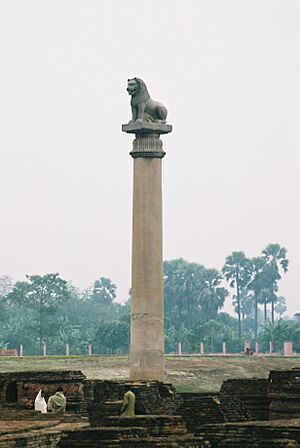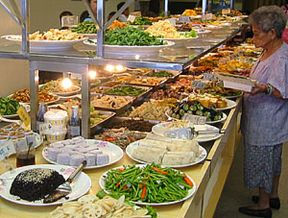Buddhist vegetarianism facts for kids
Buddhist vegetarianism is when Buddhists choose not to eat meat. This practice is followed by many Buddhist monks, nuns, and some regular followers. Different Buddhist groups, called schools of thought, have slightly different ideas about it. Many Mahayana Buddhists, for example, believe the Gautama Buddha taught that his followers should avoid eating any animal flesh. This is because all living beings are important.
Contents
Early Buddhist Practices

Some of the oldest writings about Buddhism come from King Ashoka, a famous Buddhist ruler. He helped spread Buddhism across Asia. His writings, called the Edicts of Ashoka, were made around 257 BCE.
In these edicts, King Ashoka said that animal sacrifices were not allowed in his empire. He also showed that he himself chose to be a vegetarian. This suggests that even in early Buddhism, many people, especially regular followers, might have eaten vegetarian meals.
Different Buddhist Views on Meat
Buddhists have different ideas about whether eating meat is allowed. Some Buddhists avoid meat because of the first main rule in Buddhism: "I promise not to take life." This rule encourages kindness to all living things. However, other Buddhists have different views on this.
Theravada Buddhist View
In Theravada Buddhism, which is common in countries like Sri Lanka and Thailand, monks usually eat what people offer them as alms (donations of food). The Buddha himself said that monks should accept any food given with good intentions, even meat.
However, there are some rules. Monks should not eat meat if they saw, heard, or suspected that an animal was killed just for them. This means if the animal was already killed for other reasons, or if it was found, it could be eaten.
There were also rules against eating meat from 10 specific animals. These included humans, elephants, horses, dogs, snakes, lions, tigers, leopards, bears, and hyenas. This was partly because eating such meat might cause problems or give the Buddhist community a bad name.
Mahayana Buddhist View
Mahayana Buddhism, common in China, Korea, and Japan, often has stricter views on vegetarianism. Many Mahayana texts say that the Buddha taught his followers not to eat any kind of meat or fish. Some even say that if vegetarian food touches meat, it should be washed before eating.
The Buddha in some Mahayana teachings strongly spoke against eating meat. He said it goes against being kind and compassionate to all living beings. He also taught that all beings are connected. Eating meat, he said, "stops the seed of Great Kindness" from growing. He clearly stated that monks should not accept meat even if it's offered to them.
Many Mahayana followers who are not monks also eat vegetarian meals on special dates. These "vegetarian dates" can be for a few days or even up to three months a year. Important days like the Buddha's birthday or the birthday of the bodhisattva Avalokiteśvara are often vegetarian days.
Vajrayana Buddhist View
Some followers of Vajrayana Buddhism, which is common in Tibet, do eat meat. This is often because in places like Tibet, it can be very hard to find vegetables, especially in the past. Meat was sometimes needed for survival.
However, even in Tibet, some important Buddhist teachers have encouraged vegetarianism since the 14th century. Today, leaders like the Dalai Lama and the 17th Karmapa ask their followers to be vegetarian whenever they can.
Common Practices Today
Theravada Countries
In countries like Sri Lanka and parts of Southeast Asia, monks still follow the rule of accepting almost any food offered to them. They will only refuse meat if they think it was killed specifically for them.
East Asian Traditions
In China, Korea, Vietnam, and Taiwan, Buddhist monks and nuns usually avoid meat, eggs, and dairy products. They also traditionally avoid certain strong-smelling vegetables like garlic, onions, and leeks. This is called "pure vegetarianism" or "veganism."
Many regular Buddhist followers in these countries also eat vegetarian meals on special days. These include Lunar New Year's Eve, holidays, and the first and fifteenth days of the lunar calendar. Some also follow vegetarian diets on specific "six-day" or "ten-day" schedules.
Japanese Traditions
Chinese Buddhism came to Japan in the 6th century. In 675, a Japanese emperor even banned eating meat from cows, horses, dogs, monkeys, and roosters. However, people in Japan still ate other animal products like deer and wild boar for a long time.
Later, new Buddhist schools in Japan, like Zen and Pure Land Buddhism, became popular. Some of these schools did not emphasize vegetarianism as much. However, Zen Buddhism generally supports vegetarianism. Shingon Buddhism also recommends it at certain times.
Japanese Buddhist vegetarian food is called Shojin Ryori. It means not using meat and also avoiding the five strong-smelling vegetables (garlic, onions, etc.). In 1872, the ban on eating red meat was lifted in Japan. This caused some resistance, as some monks felt it was "destroying the soul of the Japanese people."
Tibetan Traditions
In Tibet, where vegetables are often scarce, meat is still eaten by many. However, the idea of not harming living beings is very important in all Buddhist teachings. The Buddha gave rules about eating meat for monks, especially since they rely on food given to them. He made it clear that eating meat was different from killing.
Even with the challenges, many important Tibetan Buddhist teachers have encouraged vegetarianism. They ask their followers to choose vegetarian options whenever possible, showing kindness to all living things.
Images for kids





